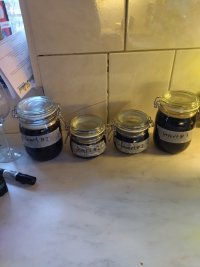Due to extremely poor dissociation at pH 2.2 Lactic Acid is an amazingly weak acid at pH 2.2. If
@cire's notes are correct and it takes 0.3 mL of 6 Molar HCL to move 500 mL of deionized water to pH 2.2, then (assuming I've done this correctly) it might take about 7.1 mL of 88% Lactic Acid to accomplish the same task.
Who would like to add 7.1 mL of 88% Lactic Acid to half a Liter of distilled or deionized water and measure the resulting pH whereby to verify this?
If (and this is a big
IF) I'm even close to being correct here, then it wouldn't be at all wise to use Lactic Acid to move water to pH 2.2. The flavor of the Invert Sugar would be destroyed.




















































![Craft A Brew - Safale S-04 Dry Yeast - Fermentis - English Ale Dry Yeast - For English and American Ales and Hard Apple Ciders - Ingredients for Home Brewing - Beer Making Supplies - [1 Pack]](https://m.media-amazon.com/images/I/41fVGNh6JfL._SL500_.jpg)







